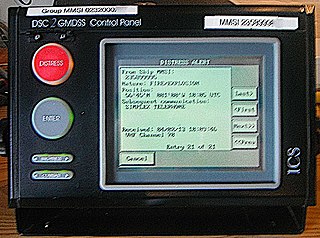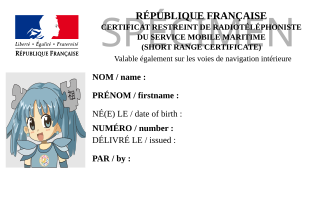Related Research Articles
Mayday is an emergency procedure word used internationally as a distress signal in voice-procedure radio communications.
Sécurité is a procedure word used in the maritime radio service that warns the crew that the following message is important safety information. The most common use of this is by coast radio stations before the broadcast of navigational warnings and meteorological information.
SOS is a Morse code distress signal, used internationally, that was originally established for maritime use. In formal notation SOS is written with an overscore line, to indicate that the Morse code equivalents for the individual letters of "SOS" are transmitted as an unbroken sequence of three dots / three dashes / three dots, with no spaces between the letters. In International Morse Code three dots form the letter "S" and three dashes make the letter "O", so "S O S" became a common way to remember the order of the dots and dashes.

A radiotelephone, abbreviated RT, is a radio communication system for conducting a conversation; radiotelephony means telephony by radio. It is in contrast to radiotelegraphy, which is radio transmission of telegrams (messages), or television, transmission of moving pictures and sound. The term is related to radio broadcasting, which transmit audio one way to listeners. Radiotelephony refers specifically to two-way radio systems for bidirectional person-to-person voice communication between separated users, such as CB radio or marine radio. In spite of the name, radiotelephony systems are not necessarily connected to or have anything to do with the telephone network, and in some radio services, including GMRS, interconnection is prohibited.
A distress signal, also known as a distress call, is an internationally recognized means for obtaining help. Distress signals are communicated by transmitting radio signals, displaying a visually observable item or illumination, or making a sound audible from a distance.

Marine VHF radio is a worldwide system of two way radio transceivers on ships and watercraft used for bidirectional voice communication from ship-to-ship, ship-to-shore, and in certain circumstances ship-to-aircraft. It uses FM channels in the very high frequency (VHF) radio band in the frequency range between 156 and 174 MHz, inclusive, designated by the International Telecommunication Union as the VHF maritime mobile band. In some countries additional channels are used, such as the L and F channels for leisure and fishing vessels in the Nordic countries. Transmitter power is limited to 25 watts, giving them a range of about 100 kilometres.
The Global Maritime Distress and Safety System (GMDSS) is a worldwide system for automated emergency signal communication for ships at sea developed by the United Nations' International Maritime Organization (IMO) as part of the SOLAS Convention.

Digital selective calling or DSC is a standard for transmitting predefined digital messages via the medium-frequency (MF), high-frequency (HF) and very-high-frequency (VHF) maritime radio systems. It is a core part of the Global Maritime Distress Safety System (GMDSS).
The radio frequency of 500 kilohertz (500 kHz) had been an international calling and distress frequency for Morse code maritime communication since early in the 20th century. For most of its history, this international distress frequency was referred to by its equivalent wavelength, 600 meters, or, using the earlier frequency unit name, 500 kilocycles or 500 kc.
A second mate or second officer (2/O) is a licensed member of the deck department of a merchant ship holding a Second Mates Certificate of Competency, which is issued by the administration. The second mate is the third in command and a watchkeeping officer, customarily the ship's navigator. Other duties vary, but the second mate is often the medical officer and in charge of maintaining distress signaling equipment. On oil tankers, the second mate usually assists the chief mate with the Cargo operations.

The radio frequency 2182 kHz is one of the international calling and distress frequencies for maritime radiocommunication in a frequency band allocated to the mobile service on first priority ("primary") basis, exclusively for distress and calling operations.
The General Radiotelephone Operator License (GROL) is a license granted by the U.S. Federal Communications Commission (FCC) that is required to operate certain radio equipment. It is required for any person who adjusts, maintains, or internally repairs FCC licensed radiotelephone transmitters in the aviation, maritime, and international fixed public radio services. It is also required to operate any compulsorily equipped ship radiotelephone station with more than 1,500 watts of peak envelope power, a voluntarily equipped ship, or an aeronautical station with more than 1,000 watts of peak envelope power. The GROL is not required for engineering jobs in radio and television broadcasting. It is obtained by taking a test demonstrating an adequate knowledge of the technical and legal aspects of safe radio operation.
Procedure words are words or phrases limited to radio telephone procedure used to facilitate communication by conveying information in a condensed standard verbal format. Prowords are voice versions of the much older procedural signs for Morse code which were first developed in the 1860s for Morse telegraphy, and their meaning is identical.
Telenor Kystradio is a part of Telenor and provides maritime telecommunication services along the coast of Norway, operating networks of marine VHF radio, medium frequency, high frequency and Navtex transmitters. As of January 2018 there are two coastal radio stations in Norway, Kystradio nord and Kystradio sør. The agency also issues marine radio licenses for both commercial- and pleasure ships, including callsigns and Maritime Mobile Service Identities, as well as radio operator certificates. Telenor Kystradio head office is based at Telenor Norway's head office at Fornebu. Telenor Kystradio also performs GMDSS Radio inspections, and are approved by the Norwegian Maritime Authority as well as most mayor classification authorities. The Radioinspeksjonen is located in Oslo, Stavanger, Bergen, Ålesund, Sandnessjøen, Bodø, Lofoten and Troms.
An international distress frequency is a radio frequency that is designated for emergency communication by international agreement.

A Yachtmaster qualification is a certificate of competence of the ability to handle either a sailing boat or motor boat in certain prescribed conditions. Three different titles are specified; Yachtmaster Coastal, Yachtmaster Offshore, and Yachtmaster Ocean which specify the level of competence required and the area of operation certified.

The AIS-SART is a self-contained radio device used to locate a survival craft or distressed vessel by sending updated position reports using a standard Automatic Identification System (AIS) class-A position report. The position and time synchronization of the AIS-SART are derived from a built in GNSS receiver . Shipboard Global Maritime Distress Safety System (GMDSS) installations include one or more search and rescue locating devices. These devices may be either an AIS-SART, or a radar-SART.
A coastal skipper is a yachtsman or woman who has the ability to skipper a yacht in coastal waters by day or night. There is a shorebased course which provides the background knowledge required, a practical course which teaches the skills and techniques required, and a Certificate of Competence.
APRS Calling is a manual procedure for calling stations on the Automatic Packet Reporting System (APRS) to initiate communications on another frequency, or possibly by other means. It is inspired by Digital Selective Calling, a part of the Global Maritime Distress Safety System. It also builds on existing digital procedures inherited from morse code and radioteletype operation. ITU Q codes are used in conjunction with APRS text messages to implement APRS calling. APRS calling is intended to complement monitoring voice calling frequencies.

The Short Range Certificate is an internationally valid certificate issued to marine radio station operators. It entitles the holder to participate in marine communications on leisure crafts using Marine VHF radio and DSC, while in the GMDSS A1 sea areas.
References
- ↑ "ECC RECOMMENDATION (10)03: HARMONISED CEPT EXAMINATION PROCEDURES FOR THE LONG RANGE CERTIFICATE (LRC) FOR NON-SOLAS VESSELS" (PDF). European Communications Office Document Database. Retrieved 3 April 2016.
- ↑ "GMDSS Certificates". Association of Marine Electronic and Radio Colleges. Retrieved 3 April 2016.
- ↑ "Radio examinations and certificates in boating". Viestintävirasto FICORA. Finnish Communications Regulation Authority. Retrieved 3 April 2016.
- ↑ "Long Range Certificate". Chieftain Training. Retrieved 26 December 2022.
- ↑ "LRC Exam". AMERC. Retrieved 26 December 2022.